7 Best Trendelenburg Gait Exercises (with Pictures!)
Also known as hip drop, the trendelenburg gait is a symptom of muscular weakness commonly seen in the elderly or those who have sustained an injury that impacts the area around their pelvis and femur.
Much like other conditions caused by muscular weakness, some of the most effective methods of remedying this issue involve performing targeted exercises that address the root cause of the trendelenburg gait.
For the most part, exercises meant to rehabilitate the trendelenburg gait target the hip flexors and gluteal muscles at a lower level of intensity and resistance, usually in a unilateral manner so as to better target the weaker side of the body.
What is Trendelenburg Gait?
The trendelenburg gait is a certain way of walking that features a marked drop of the pelvis while the patient is moving from one foot to the other, producing a gait that appears as one side of the hip lowering over the moving leg in an unbalanced fashion.
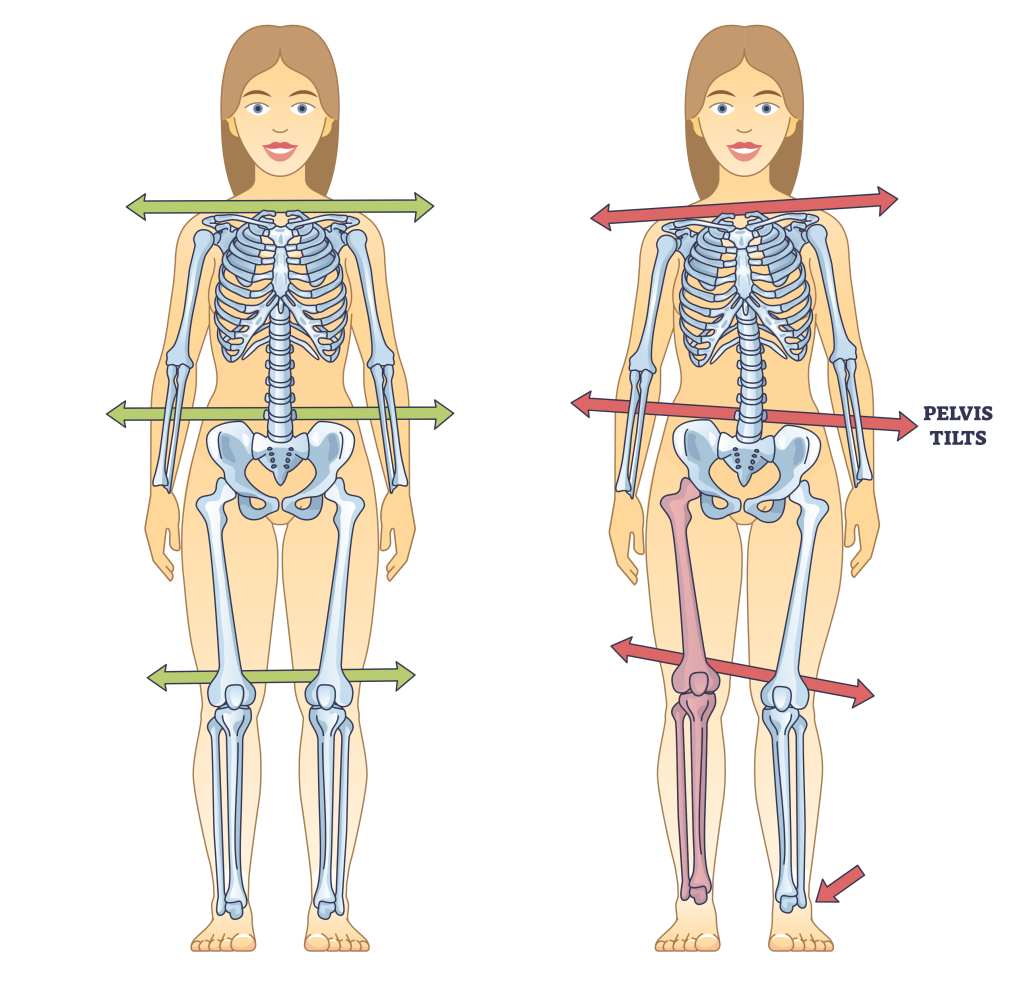
The trendelenburg gait can lead to all sorts of concurrent physiological issues, but is most often seen as simply a symptom of unilateral muscular weakness around the pelvic area of the body.
While the trendelenburg gait is not immediately dangerous or likely to interfere with the patient’s activities, it can reduce quality of life and result in pain and reduced mobility in the long term.
Why Does Trendelenburg Gait Occur?
Trendelenburg gait is primarily caused by a one-sided weakness of the muscles that move the hips; either the hip abductors or those of the gluteal muscles that make up the buttocks.
Trendelenburg gait is primarily caused by a one-sided weakness of the muscles that move the hips, either the hip adductors and abductors or the gluteal muscles that make up the buttocks.
It should be noted that general muscular weakness of the hip flexors is unlikely to cause trendelenburg gait, as such a movement pattern is specifically due to unilateral muscular weakness, and not bilateral muscular weakness.
In certain cases, trendelenburg gait can be caused by physiological problems other than muscular weakness, such as hip bursitis, bone density loss in the hips, or even dislocated hip-femur joints.
However, these conditions are usually accompanied by other symptoms, and are otherwise more difficult to correct than simply muscular weakness.
What are the Dangers of the Trendelenburg Gait?
If trendelenburg gait is your sole symptom, it’s pretty unlikely that any damage will be done in the short term (apart from those sustained by poor balance), and it is otherwise a matter of low concern.
In most cases, trendelenburg gait can be self-corrected within the comfort of an individual’s home, and will only rarely require direct in-patient physical rehabilitation.
How to Rehabilitate Trendelenburg Gait with Exercise
Slow and Controlled Repetitions
When attempting to rehabilitative trendelenburg gait with resistance exercise, the afflicted Person should strive to maintain a slow tempo as they go through their repetitions, focusing on achieving maximum contraction with the affected side of the muscle group.
Due to the underlying muscular weakness that is responsible for trendelenburg gait, performing exercises too rapidly can lead to injury or premature fatigue that can otherwise set you back in terms of recovery.
Furthermore, isometric contraction of a muscle group is one of the surest methods of ensuring strength development for regular activities - making it doubly beneficial to perform slow repetitions.
Low Volume and Low Intensity
It is important to understand that - despite the fact that we are attempting to strengthen a muscle group - the intensity of the exercise is meant to be kept at a low level, as the goal is rehabilitation rather than physical development.
This means that performing exercises meant to correct trendelenburg gait are not otherwise meant to be executed with the volume and resistance that is normally associated with bodybuilding or strength-developing exercises.
Even if it feels as if you are capable of doing more repetitions or at a greater level of resistance, it is best to temper the intensity of the exercise so as to allow for a greater rehabilitative effect.
When to Avoid Exercising with Trendelenburg Gait
Though exercising is one of the surest ways to rehabilitate trendelenburg gait caused by a muscular weakness, certain other causes can actually have quite the opposite effect when exercise is involved - potentially worsening the movement disorder or otherwise causing even more symptoms to develop.
Trendelenburg gait caused by recent surgery, osteoporosis or similar degenerative disorders and necrosis of the hip are all worsened when subjected to the force and pressure of regular exercise.
It is best to consult a physician prior to attempting this sort of physical rehabilitation.
Trendelenburg Gait Exercises
1. Bodyweight Box Squats
The bodyweight box squat is a variation of the standard bodyweight squat that places large emphasis on recruitment of the gluteal muscles, resulting in reinforcement of the hip abduction and hip adduction biomechanics as the glutes develop.
It is most often performed for a few low volume sets when used for the purposes of rehabilitation, and can be frequently seen in the latter stages of a rehabilitative program once the majority of hip range of motion is achieved.
Who Should Rehabilitate Trendelenburg Gait with Bodyweight Box Squats?
Bodyweight box squats are most efficient as a rehabilitative tool for individuals with only a minor muscular weakness of the hip flexor muscles and glutes.
They are considered less suitable for individuals with more severe trendelenburg gait or its subsequent causes, as the resistance employed (the bodyweight of the patient) may be too heavy for those with more advanced degenerative conditions or muscular weaknesses.
How-to: Bodyweight Box Squat
To perform bodyweight box squats, the exerciser should select an exercise bench or chair at the same elevation as their comfortable squat depth.
Then, once a suitable object has been found, the exerciser will lower themselves to the chair or bench by bending at the hips and knees simultaneously - pushing their pelvis backwards as much as possible and attempting to keep a neutral lower back curve as they do so.
Once the exerciser’s body weight is fully rested atop the chair, they will then draw themselves upwards by squeezing the gluteal muscle group and pushing their heels into the floor, stopping once they have returned to a standing position with the knees fully extended.
As was previously mentioned, it is important to go about performing this exercise in a slow and controlled manner, as doing so too rapidly can aggravate whatever condition is causing the exerciser’s trendelenburg gait symptom.
2. Side Planks
Side planks are a unilateral isometric exercise that are highly effective at treating trendelenburg gait caused by a hip flexor muscular imbalance, especially in cases where dynamic movement throughout the muscle group’s range of motion is limited due to injury or age.
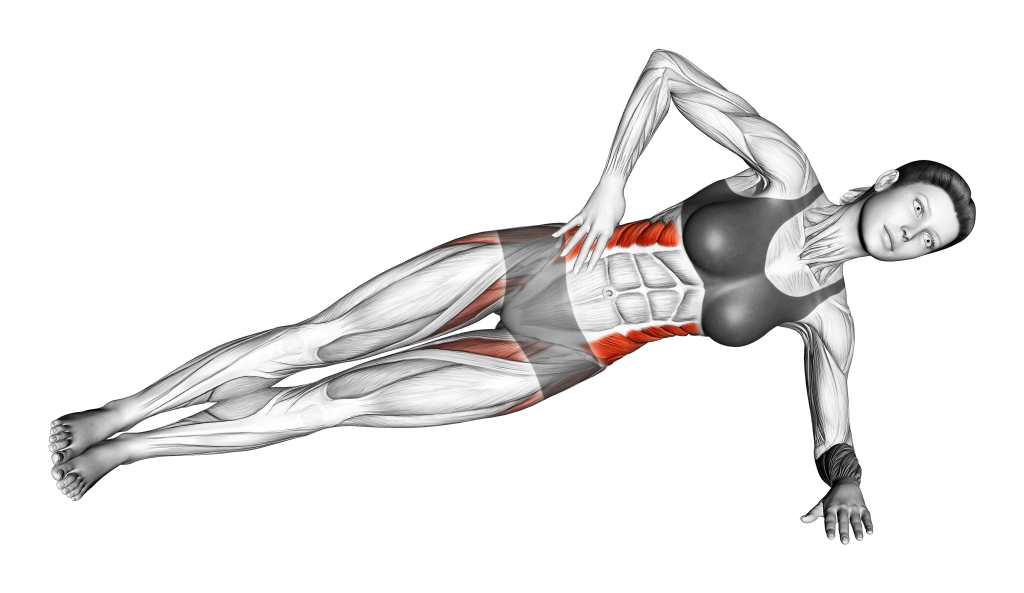
Side planks are also perfectly suitable for home-based rehabilitation, as they require no equipment and the intensity of the exercise is entirely governed by the length of time in which it is performed, rather than repetitions or weight.
Who Should Rehabilitate Trendelenburg Gait with Side Planks?
Side planks are most effective as a rehabilitory tool for trendelenburg gait in cases of unilateral muscular weakness of the hips, obliques, or other abdominal muscle groups.
How-to: Side Plank
Lying the exerciser on their side atop a yoga mat, the leg opposite to the one against the ground should be resting atop said lower leg, with the torso supported on the forearm and elbow of the same side.
To begin the exercise, the exerciser will form a straight line with their body, flexing their abdominal muscles and balancing on their feet and elbow for a predetermined length of time.
Once a sufficient length of time has passed, the exerciser will switch to the other side so as to complete the repetition.
3. Step Ups
Step ups are a more direct and dynamic rehabilitation exercise meant to correct trendelenburg gait through leveraging the bodyweight of the exerciser in a way that targets the posterior chain and hip flexor muscles.
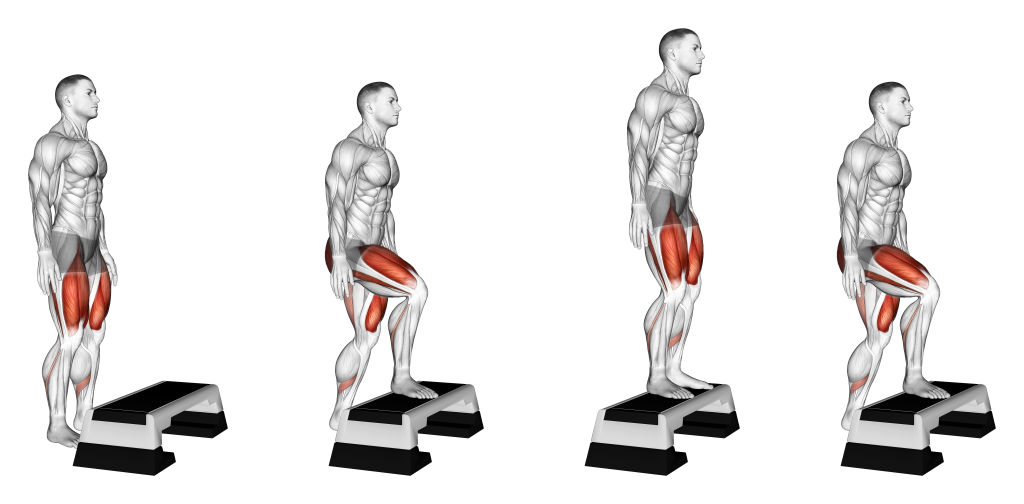
Step ups require a plyometric box or similarly low object with which to act as a step for the exerciser, and is otherwise primarily reserved for individuals with only minor trendelenburg gait due to the relative intensity of the exercise itself.
Who Should Rehabilitative Trendelenburg Gait with Step Ups?
Step ups (much like bodyweight box squats) are better reserved for individuals in the advanced stages of rehabilitation, or those whose underlying cause of trendelenburg gait is minor enough to allow for dynamic and load-bearing movements of the lower body.
Individuals with more severe muscular weaknesses or a history of injury may be better served with lower impact and lower intensity rehabilitative exercises, as performing the step up exercise in this condition can possibly worsen the symptoms.
How-to: Step Up
To perform step ups, the exerciser will stand facing their stepping object with their feet a natural distance apart.
Then, the exerciser will place one foot on the stepping object and draw themselves upwards, as if climbing a set of stairs. Once both feet are atop the step, the exerciser will then reverse the motion and once again lower themselves back to the ground by stepping off the step.
This completes a single repetition of the step up, and is repeated as many times as necessary to finish the set.
4. Glute Bridges
An exercise favored for its combination of isometric and dynamic muscular contraction of the various muscles responsible for trendelenburg gait, glute bridges require little to no equipment and are considered to be quite effective at remedying posterior chain or hip flexor weakness in otherwise healthy individuals.
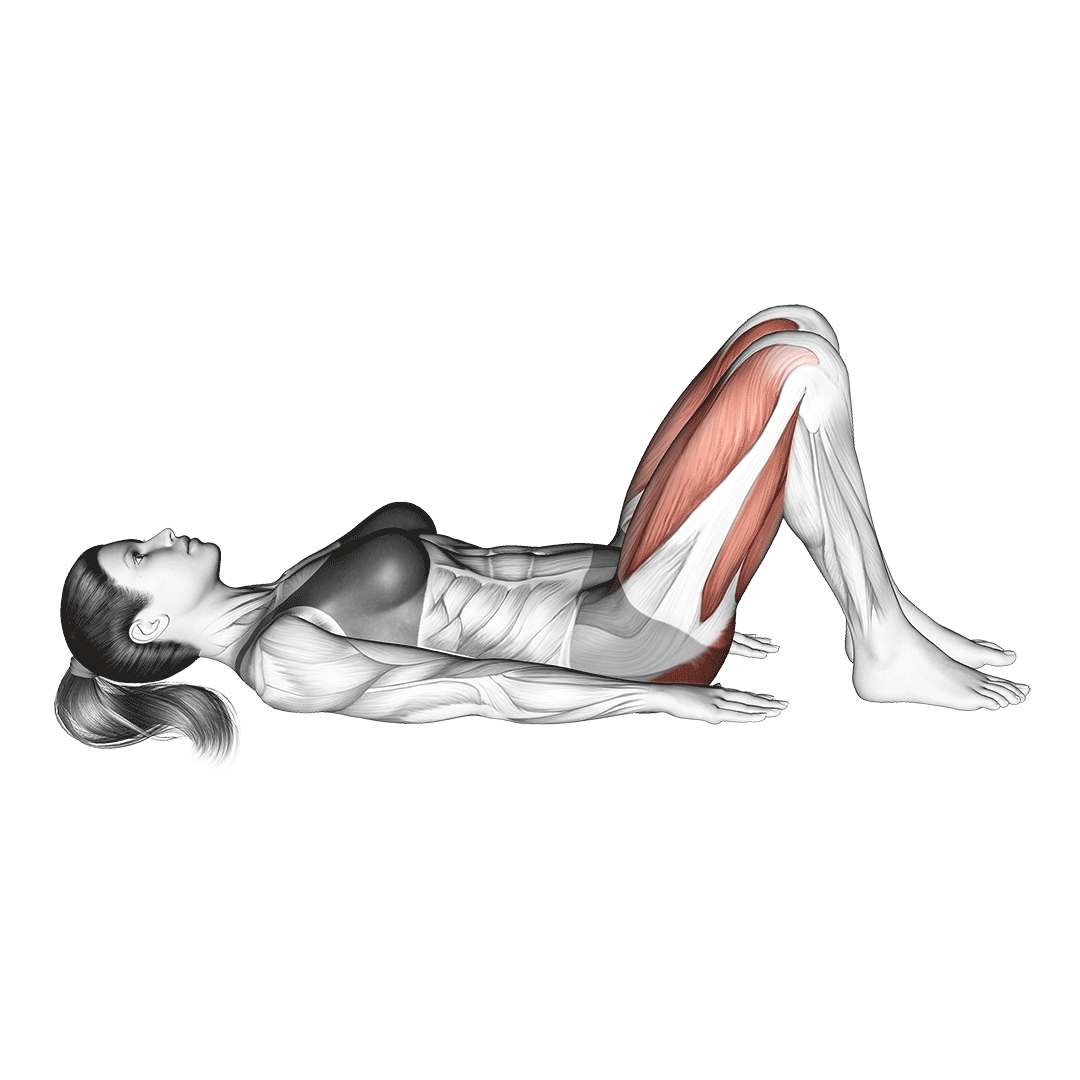
Furthermore, their simplicity and lack of excessive resistance makes them quite safe and suitable for even first-time exercisers wishing to rehabilitate their gait disorder.
Who Should Rehabilitative Trendelenburg Gait with Glute Bridges?
Glute bridges are suitable for the majority of patients with trendelenburg gait, but special precaution must be taken for individuals with a history of currently present risk of lower back injury, as excessive pelvis extension can place the lower back muscles at risk of strain.
In particular, glute bridges are the most suitable rehabilitative tool for the elderly or novice exercisers with gluteal muscle weakness being the primary culprit of their trendelenburg gait symptoms.
How-to: Glute Bridge
Lying on their back, the exerciser will place both heels on the ground as they bend their knees, flexing their core and keeping their arms against the ground so as to provide a more stable base for the exercise.
Then, driving the heels into the ground and squeezing the buttocks together, the exerciser will push their pelvis upwards in a slow and controlled manner, stopping once they have reached the full range of motion of their hips.
Once reaching the apex of the repetition, they will simply reverse the motion in a similarly slow manner, lowering their pelvis back to the floor.
This completes a repetition of the glute bridge exercise, and may be repeated as needed to complete the set.
What Exercises are Suitable for Severe Trendelenburg Gait Rehabilitation?
In cases where the Trendelenburg gait (or its subsequent cause) are severe enough to make the aforementioned exercises dangerous or difficult to perform, medical professionals may prescribe the following movement to the patient.
Note that physical rehabilitation is not always effective at treating Trendelenburg gait, especially if it is caused by problems like nerve damage, osteonecrosis or if the Trendelenburg gait has been left untreated for so long that secondary pathologies have been developed.
5. Lying Side Hip Abduction
Whether loaded with a resistance band or performed with no equipment, the lying side hip abduction exercise is a rehabilitation movement meant to target the hip abductor muscles of the afflicted side.
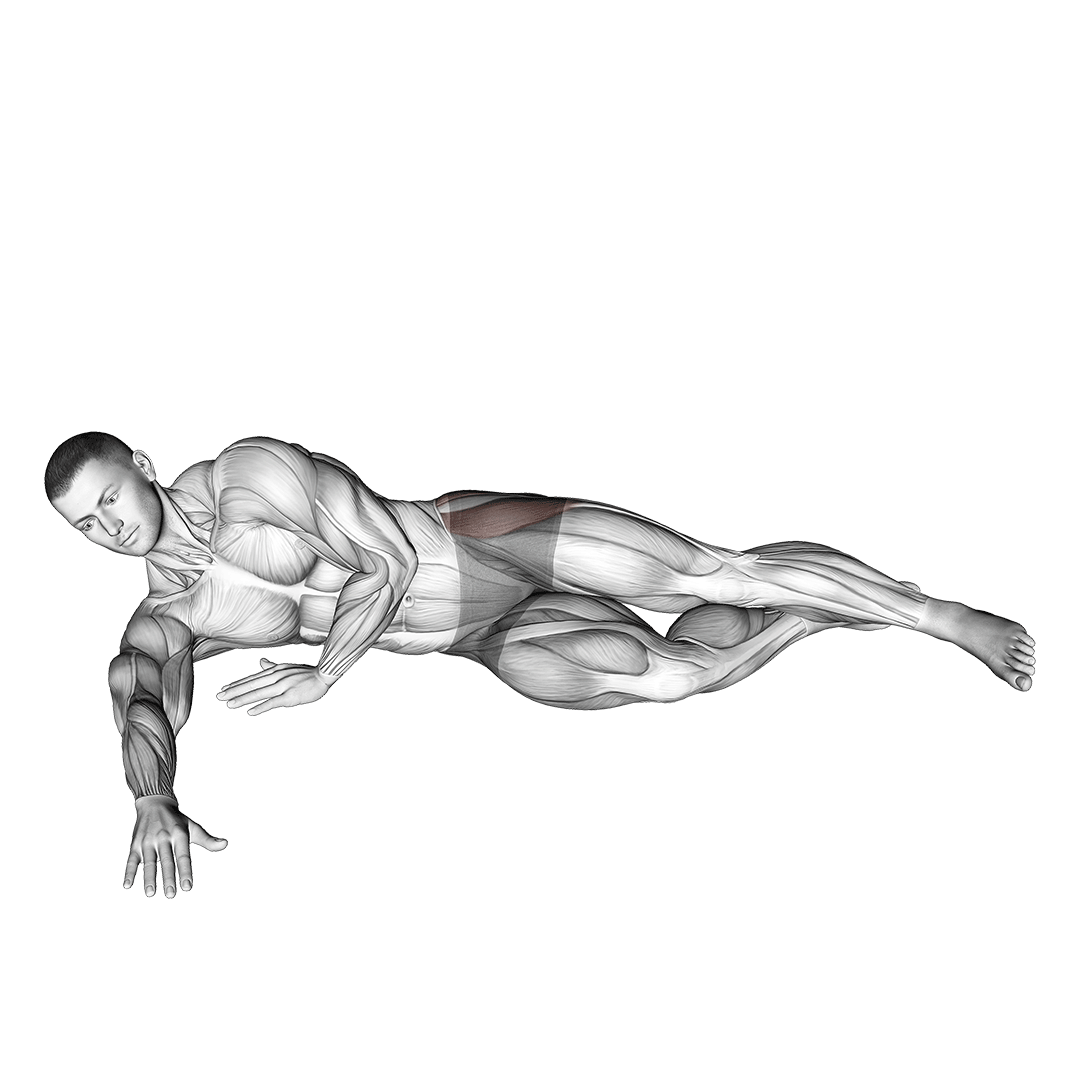
Who Should Rehabilitate Trendelenburg Gait with Lying Side Hip Abductions?
Lying side hip abductions are usually performed in a physical therapy clinic for patients that cannot perform any other hip abductor exercise - especially those with concurrent injuries that prevent them from standing upright.
In terms of difficulty or impact, they are accessible to all but the most severely affected of individuals, and are often seen as one of the most basic of movements for Trendelenburg gait.
How-to:
Lying on the “drooping” or compensatory side, the exerciser will fully extend their knee as it lies parallel to the floor, before raising it at the hip in an upward direction, stopping once they have reached the terminal point of their hip abductor’s range of motion.
For exercisers who are unable to do this, it is possible to keep the feet together and instead raise the leg at the knee (without full leg extension), thereby greatly reducing the difficulty of the movement and allowing them to progress to the fully-extended variation of the exercise.
The non-extended variation of this exercise is also known as the side-lying clamshell exercise.
That movement looks like this:

6. Supported Standing Hip Abduction
Taking things a step further, exercisers who can stand but nonetheless require hip abduction reinforcement may perform the standing hip abduction exercise.
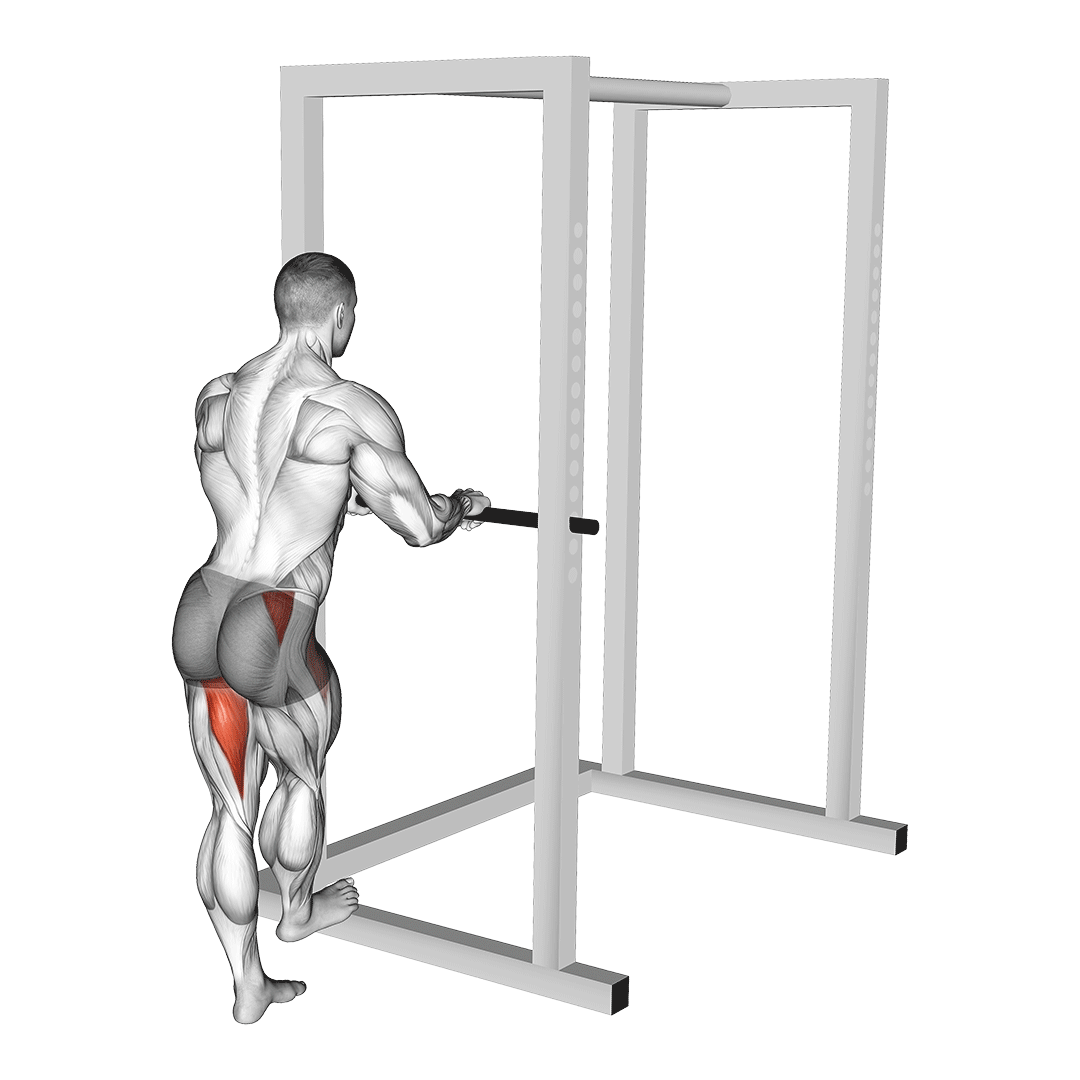
Like other movements specifically geared towards patients with severe Trendelenburg gait, it is best to perform this exercise with the advice and equipment of a professional physical therapist, even if it is admittedly quite low impact.
Who Should Rehabilitate Trendelenburg Gait with Standing Hip Abductions?
The standing hip abduction movement is most suitable for individuals that are mobile and strong enough to remain upright with one leg off the ground, though it is often used while the exerciser is supported by another individual and have both their hands against a wall so as to reduce any risk of injury.
Much like side-lying hip abductions, standing hip abductions are meant to apply careful stretching and rehabilitative stimulus to the muscles of the glutes and other hip abductor muscles, making the movement invaluable to Trendelenburg gait sufferers who cannot perform other exercises due to weakness or poor mobility.
How-to:
Standing upright and placing their hands against a wall for support, the exerciser will slowly raise the afflicted side’s leg out to the side, ensuring that they are adequately balanced on the standing leg.
Once reaching the terminal range of motion of their hip abductors, they will slowly reverse the movement, returning the foot to the ground in a similarly sideways manner.
7. Resisted Side Steps
In cases of Trendelenburg gait where the patient is mobile and strong enough to perform resisted exercise, resisted side steps may be used so as to better rehabilitate the hip abductors.
The exercise features an upright position and will require enough lower body stability to maintain balance despite the addition of resistance near the ankles or knees.
They may make use of a resistance machine or resistance band, but are nonetheless still meant to be performed with a very low level of resistance so as to avoid any untoward complications for the patient.
Who Should Rehabilitate Trendelenburg Gait with Resisted Side Steps?
Resisted side steps are more likely to be used once the patient has recovered enough mobility and strength to maintain a balanced half-squatting position.
As always, care should be taken when performing a rehabilitative movement featuring any sort of resistance.
How-to:
Standing upright with a resistance band wrapped around the knees or ankles, the exerciser will enter a half-squat position by contracting the core and bending at the hips and knees, allowing the torso to bend forward somewhat.
For the best results, tension must be maintained in the band by keeping the legs suitably far apart, as well as taking short enough steps that the unaffected leg does not need to compensate with larger movements. The trunk must also remain upright and vertically parallel to the floor so as to properly rehabilitate the hip abductor muscles.
From this half-squat position, the exerciser will take a careful step to the side using the afflicted leg, ensuring that the affected hip abductors are contracted appropriately. Once the opposite leg has followed suit, the repetition is complete.
Frequently Asked Questions (FAQ)
What Muscles are Weak in Trendelenburg Gait?
Trendelenburg gait is characterized by a dropping of one side of the pelvis while walking - an area of the body that is primarily controlled by the gluteal muscle group, with the gluteus medius and gluteus minimus in particular being of direct responsibility for the motion of the hips during actions like walking.
Which Hip is Weak in Trendelenburg Gait?
During most cases of Trendelenburg gait, it is the contralateral or opposite side of the pelvis that features a marked weakness in hip abductor muscles.
When walking or performing a Trendelenburg test, it is the opposite hip to the drooping side that is likely to be affected.
This is most often corrected through targeted physical therapy, where the correct selection of exercises and keeping a particular focus on the gluteus medius and minimus muscles is absolutely essential.
Are Hip Drop and Trendelenburg Gait the Same?
Yes - both the term "hip drop" and "Trendelenburg gait" refer to the same movement disorder caused by muscular imbalance.
However, in certain contexts, hip drop can also simply refer to one side of the pelvis lowering at a certain point, without the presence of a walking motion or otherwise.
In other pathologies, hip drop could also be indicative of weakness of the quadratus lumborum muscle on the side of the forward-swinging leg, and should also be investigated if this is suspected.
Final Thoughts
Just as is the case in any sort of physiological condition, it is best to consult a medical professional prior to attempting any sort of remedy, no matter how minor in impact they may be.
If you or someone you know is suffering from trendelenburg gait, a combination of medical supervision and rehabilitative exercises is the surest way of remedying the issue in a safe and efficient manner.
References
1. Damien Kiernan, Rory O’Sullivan, Ailish Malone, Timothy O’Brien, Ciaran K Simms, Pathological Movements of the Pelvis and Trunk During Gait in Children With Cerebral Palsy: A Cross-Sectional Study With 3-Dimensional Kinematics and Lower Lumbar Spinal Loading, Physical Therapy, Volume 98, Issue 2, February 2018, Pages 86–94, https://doi.org/10.1093/ptj/pzx113
2. Stastny, Petr PhD; Tufano, James J. MS; Golas, Artur PhD; Petr, Miroslav PhD. Strengthening the Gluteus Medius Using Various Bodyweight and Resistance Exercises. Strength and Conditioning Journal: June 2016 - Volume 38 - Issue 3 - p 91-101 doi: 10.1519/SSC.00000000000002213
3. Gandbhir VN, Lam JC, Rayi A. “Trendelenburg Gait.” [Updated 2022 Oct 6]. In: StatPearls [Internet]. Treasure Island (FL): StatPearls Publishing; 2022 Jan-. Available from: https://www.ncbi.nlm.nih.gov/books/NBK541094/ (Retrieved 09/03/2023)
